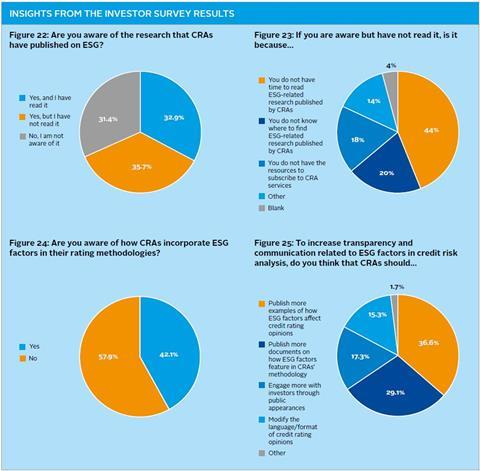An overview of the PRI’s observations on the investor-CRA disconnect related to communication and transparency.
Key messages:
- Although transparency efforts are increasing, investors and CRAs acknowledge that there is still room for improvement on the communication front.
- Outreach and engagement are becoming more common practice, but only recently, as most FI investors have just started to formally embrace ESG consideration.
- A built-in approach when considering ESG factors in credit risk analysis is more aligned with integration but appears more challenging to demonstrate than an add-on approach.
What we observed:
Most investors were unaware of the efforts that CRAs have made in recent years to improve transparency. They have produced:
-
- Publications: CRAs have been publishing research papers related to ESG and notes to show how ESG factors feature in their methodology – particularly since 2015, a key turning point in investor and CRA sensitivity to ESG consideration (likely heightened by the signing of the COP21 Paris Agreement). This push has intensified since the signing of the PRI ESG in Credit Ratings Statement.
- Dedicated webpages: These are facilitating the dissemination of ESG-related research and methodologies, and showcase the enhanced competencies that CRAs are acquiring in this area.
Few investors had engaged with CRAs specifically on ESG issues prior to the PRI events. This likely reflects the fact that this topic has historically ranked relatively low in credit risk analysis. As a result, CRA outreach to investors has hitherto been limited. Discussions also revealed that investor engagement on ESG topics with bond issuers has generally been poor.
More discussion is needed. Articulating how ESG factors impact credit risk through the roundtables is helping to advance thinking among credit practitioners. For some investors, sharing practices and challenges is helping to structure in-house debates as well as become more inquisitive on ESG topics.
| Challenges |
|---|
|
Language barriers. ESG has become a convenient, succinct acronym to describe non-traditional financial risks, but encompasses a variety of factors that are often not labelled as such or are difficult to categorise. ESG factors may also have different meanings depending on the regions where they are analysed. Participants acknowledged that agreeing on terminology might take time and that more discussion is needed. Add-on versus built-in approaches. The merits and limitations of these approaches were discussed at length. An add-on approach is more visible but carries the risk of “double counting” or evolving into an ESG assessment already provided by other third parties. A built-in approach is more challenging to demonstrate, but more aligned with ESG integration. Dedicated section in rating opinions. This point was discussed extensively and demanded by several investors to avoid double counting issues in their own analysis. CRAs have not dismissed this idea. However, they pointed out that ESG consideration filters in at various stages and through different pillars of their credit framework. Moreover, issues vary across regions and sectors. Finally, if they are not material to the rating, explaining why ESG factors have not been considered risks lengthening the rating opinion unnecessarily. Scenario analysis and stress testing. These were also discussed as tools to enhance transparency and clarify the rationale behind rating opinions, responding to increasing investor demand to understand what influence ESG consideration played (or did not play) in their formulation. However, as already highlighted in the previous section on time horizons, these solutions are helpful as risk guidance but have shortfalls in consistency and comparability. Risk that ESG consideration becomes a tick-box exercise. Some participants were concerned that spending time considering ESG factors when they are not relevant would add a burdensome administrative layer, rather than facilitate investment decision-making. Reaching out to non-PRI signatories. PRI signatories are relatively more sensitive to ESG issues but there are still many FI investors that are sceptical and do not see any benefit in ESG analysis. Some investors raised the question of how to boost awareness and advocated for more academic and market research to demonstrate their relevance. |

Download the full report
-

Shifting perceptions: ESG, credit risk and ratings – part 2: exploring the disconnects
June 2018
ESG, credit risk and ratings: part 2 - exploring the disconnects
- 1
- 2
- 3
- 4
- 5
- 6
- 7
 Currently reading
Currently readingDisconnect 4
- 8
- 9
- 10



















